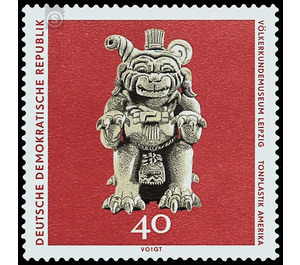Museum of Ethnology, Leipzig: Exhibits - Germany / German Democratic Republic 1971 - 40 Pfennig
Theme: Architecture
| Country | Germany / German Democratic Republic |
| Issue Date | 1971 |
| Face Value | 40.00 |
| Color | brown |
| Perforation | K 13 |
| Printing Type | Photogravure |
| Stamp Type | Postage stamp |
| Item Type | Stamp |
| Chronological Issue Number | 1377 |
| Chronological Chapter | GER-DDR |
| SID | 265340 |
| In 22 Wishlists | |
From the Museum of Ethnology in Leipzig The Ministry of Posts and Telecommunications of the German Democratic Republic publishes four multicolored special postage stamps depicting exhibits from the Museum of Ethnology in Leipzig. Ethnography The originals of the motives of this issue are in the Museum of Ethnology of Leipzig, the largest ethnographic museum on the soil of the German Democratic Republic, whose 100th anniversary roughly coincides with the appearance of this series. The brand motifs represent the four non-European continents represented in the museum's exhibitions: Australia / Oceania, Africa, Asia and America. It is probably no coincidence that three of the four depicted motifs depict ancestral-cult objects, a world-view prevalent over a long period of social evolution, and consequently happiness and unhappiness, both of the individual and of the human community and its institutions depend on the action of the spirits of deceased ancestors. The ancestral cult objects have always been carefully crafted and preciously decorated; however, according to the different levels of material culture and technical skills of their manufacturers, they are different in shape and material. The 40-pfennig value shows a sculptural clay pot from ancient Mexico. It depicts the Jaguar God adorned with feather headdress, earsticks, necklace and loincloth. Such vessels - excavated at the San Juan Igolaba settlement in Oaxaca state in southern Mexico - are typical of the so-called Oaxaca culture, whose bearers were probably the Zapotec Indians, culminating in the period around 500-800 AD falls. Vessels such as those portrayed here, with representations of deities or even priests modeled in clay, were placed in subterranean burial chambers next to the dead or placed above the entrances in niches. Dimension: height 35 cm.


